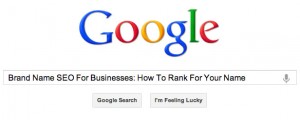Not Showing Up In Google For Your Own Brand Name?

Are people searching online for your company and not being able to find what they need?
This could be a circumstance of having a very common name for your company and so businesses from other industries are overlapping, or maybe your company name includes a popular service or product that has high competition in search engines.
Whatever the reason for your brand name SEO issues, the problem is that when a potential customer wants to find you and can’t, they end up going with a competitor instead.
Corporate SEO For Brand Names: Take Ownership Of The Web!
Having your own corporate website is not enough to take control of your digital territory. Your brand name SEO strategy needs to include on-site and off-site SEO tactics.
On-Site Brand Name SEO Tactics
Much of the on-site SEO factors are baked into the foundation of your existing website. The code should be optimized for search engines when your site is built and your Content Management System should be automatically incorporating the basics to your new pages and posts (check out this article on WordPress Post optimization tips).
To get the search engines to start checking up on your site regularly, you need to be blogging at a high frequency. This way you can build your credibility with Google much quicker and take back your share of the market that your brand name deserves. Consistent blogging not only allows you to target your brand name keywords on more pages, but by having constantly new information on your site, you will be seen as much more of an authority to your customers as well as the search engines (leading to higher search engine rankings for your brand name).
Quick Brand Name SEO Tips
While posting new content to your website in order to prove to Google that you should be the top result for your brand name, keep these simple things in mind:
- Page Title: Make sure your brand name is used in the first 70 characters of your meta page title as well as in the H1 title of your web page.
- Images: Optimize your images for brand name SEO by putting your company’s name in the filename of the image as well as using your brand name in the ALT text of the image.
- Internal Linking: Create links between relevant pages on your website, using your brand name as the anchor text. Don’t overdo this optimization as Google rewards a healthy balance of anchor text-targeted keyword, but will penalize an overly ambitious keyword stuffing attempt.
Off-Site Brand Name SEO Tactics
Your website is not the only place that people may find you. There is an abundance of social media networks, content sharing sites and online communities that have profile pages and content pages that you can incorporate into your online strategy to take over the search results for your brand name.
First, you’ll want to create and optimize as many profiles as you can. You should make sure to incorporate your brand name into your profile name in some capacity, even if your direct brand name is already taken (due to the reasons stated in the first paragraph). That’s also why it’s very important to CREATE YOUR SOCIAL MEDIA PROFILES IMMEDIATELY TO CLAIM YOUR COMPANY’S NAME BEFORE SOMEONE ELSE DOES.
Make sure that you fill out all of your profiles completely, giving all of the information that the page allows (i.e., name, bio, history, pictures, video, links to your site and other profiles, services, products, etc.). The more complete your profile is, the better chance you have of getting found. Use the same brand name SEO tips from above when filling out these profiles.
3 Main Reasons For Owning More Of The Web For Your Brand Name SEO Strategy
There are three main reasons that you want to have as many online profiles for your business as possible:
- Creating more profiles that link back to your website will enhance your credibility with the search engines, therefore improving your search engine rankings. Not just having profiles, but sharing content on those other websites is key to building your authority with the search engines (as well as with your customers, which is really the ultimate goal).
- Google is not the only search engine. People may be searching for your brand (or more likely your products, services or specialties) in other places. YouTube is the second largest search engine (higher than Yahoo and Bing).If people are searching SlideShare or Vimeo for content, you want to be able to show up in front of your customers there as well.
- Search engines show results for more than just website pages of companies. If someone is searching for a product or service that you offer, Google may show a presentation from your SlideShare profile above a web page from one of your competitors. If someone is searching for your brand name, your own website will (hopefully) be showing up, but you’ll also own these other web properties with your brand name as well. That means that other companies that share your brand name or competitors trying to outrank you for your own name (yes, that does happen) will have a tougher time competing against your well rounded, online presence.
Are You Having Trouble With Brand Name SEO?
Have you previously had a brand name SEO issue that you’ve overcome? What strategies and tactics worked for you? Are you currently having trouble with your company not showing up in Google search results? How do you plan on solving this issue? Leave your thoughts and ideas in the comments below!
